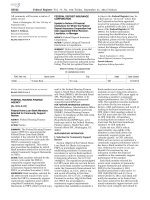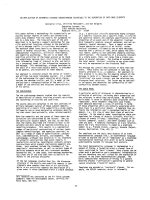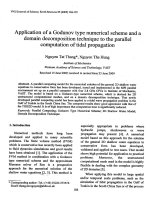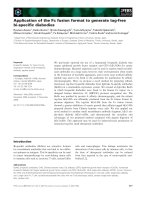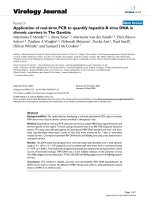Scientific report: "Application of PCR to detect the presence of two genes in the genome of rice AtAOS has been genetically modified" pdf
Bạn đang xem bản rút gọn của tài liệu. Xem và tải ngay bản đầy đủ của tài liệu tại đây (771.87 KB, 8 trang )
J. Sci. Dev. 2009, 7 (Eng.Iss.1): 9 - 16 HA NOI UNIVERSITY OF AGRICULTURE
9
Application of PCR to identify the transgene
(Arabidopsis thaliana allene oxide synthase 2) in
transgenic rice plants
Ứng dụng PCR để phát hiện sự có mặt của gen AtAOS 2
trong genome của lúa đã được chuyển gen
Nguyen Thi Thuy Hanh
1
, Han Oksoo
2
1
Faculty of Agronomy, Hanoi University for Agriculture
2
College of Agriculture and Life sciences, Chonnam National University, South Korea
TÓM TẮT
Allene oxide synthase (AOS) là một enzyme quan trọng trong số các enzyme tham gia vào quá
trình tổng hợp axit jasmonic thông qua con đường sinh hoá octadecanoid. Ở thực vật, axit jasmonic
đóng vai trò then chốt trong việc hình thành các phản ứng đáp lại các tác động của môi trường trong
và ngoài tế bào. Để làm tăng hàm lượng enzyme allene oxide synthase nội sinh ở lúa, gen allene
oxide synthase 2 của Arabidopsis thaliana (AtAOS 2) đã được chuyển vào genome của lúa (Oryza
sativa L.Japonica cv. Nakdong). Phản ứng PCR đã được sử dụng để phát hiện sự có mặt của gen
AtAOS2 trong genome của lúa đã được chuyển gen. Cụ thể là phản ứng PCR đã được sử dụng để
phát hiện gen tổng hợp chất kháng sinh hygromycin, promoter CaMV35S (promoter này nằm ngay
phía trước gen AtAOS2 trong cấu trúc của vector pCAMBIA1201/AtAOS) và gen AtAOS 2 trong
genome của lúa.
Từ khoá: Allene oxide synthase, axit jasmonic, con đường sinh hoá otadecanoid, thực vật
chuyển gen.
SUMMARY
Allene oxide synthase (AOS) is an important regulator that steers the octadecanoid pathway
toward jasmonic acid (JA) synthesis. Plant jasmonic acid (JA) plays pivotal roles regulating cellular
responses against environmental cues, including the innate immune response(s). The Arabidopsis
thaliana allene oxide synthase 2 (AtAOS 2) gene was introduced into rice (Oryza sativa L.Japonica
cv.Nakdong) genome. The polymeraza chain reactions (PCRs) were applied to indentify the transgene
- AtAOS 2 in transgenic rice plants. A set of PCRs was carried out to detect the hygromycin resistance
gene, CaMV35S promoter (the pomoter located infront of the AtAOS 2 gene in pCAMBIA1201/AtAOS
binary vector) and the AtAOS 2 gene in the transgenic rice genome.
Key words: Allene oxide synthase, jasmonic acid, octadecanoid pathway, transgenic plants.
1. INTRODUCTION
Plants have evolved defense strategies to
protect themselves from various abiotic and biotic
stresses. One of the most prominent defense
mechanisms is the octadecanoid pathway, which
leads to jasmonic acid (JA) biosynthesis. JA is a
genuine plant hormone that has various
physiological functions, including growth control,
senescence promotion, responses to wounding and
drought, and defenses against insects and pathogens
(Schaller et al., 2005). Furthermore, JA signaling
interacts with signaling of other plant hormones such
as ethylene and salicylic acid to form a complex
signaling network (Devoto et al., 2005). JA is
synthesized through the octadecanoid pathway
(Figure 1). In the octadecanoid pathway, 13 (S) -
HPOT is the pivotal intermediate, from which
several metabolic pathways branch out. For the JA
synthesis, 13 (S) - HPOT is converted to an unstable
allene oxide, 12,13 - epoxy - 9Z, 11E, 15Z -
octadecatrienoic acid (12,13 - EOT), by an allene
oxide synthase (AOS). The allene oxide is readily
converted to cis-(+)-OPDA by allene oxide cyclase
Application of PCR to identify the transgene (Arabidopsis thaliana allene oxide synthase2)
10
(AOC); cis-(+)-OPDA is further metabolized
through reduction and β-oxidation to JA. On the
other hand, 13(S)-HPOT can also be metabolized by
other enzymes, including hydroperoxide lyase,
peroxygenase, hydroperoxide reductase, and divinyl
ether synthase. A typical function of these branch
pathways is defence against insect and pathogens
(BlÐe, 2002). Therefore, AOS is an important
regulator that steers the octadecanoid pathway to JA
synthesis, thus affecting the synthesis of all JA-
related compounds (Kongrit et al., 2007).
Rice AOS (OsAOS) and Arabidopsis
thaliana AOS belong to the CYP74A subfamily.
A database search indicates that, besides the
characterized OsAOS1 (Agrawal et al., 2004),
there are at least four additional OsAOS
(OsAOS2-5) genes in the rice genome (Figure 2).
Most of the rice AOS genes are located on
chromosome 3, except for the OsAOS3 gene, that
is located on chromosome 2. The OsAOS proteins
show putative localization sites such as
mitochondria (MC), endoplasmic reticulum (ER),
plasma membrane (PM), microbody (MB), and
cytosol (CS) (Agrawal et al., 2004). Three
Arabidopsis thaliana AOS genes (AtAOS1-3)
have been identified. All AtAOS genes are located
on chromosome 5. Arabidopsis thaliana AOS
proteins localize on chloroplast (CP), microbody
(MB), mitochondria (MC). In order to increase the
level of endogenous JA in rice, we try to over
express AOS genes by transforming AtAOS2 gene
to the rice genome
Fig. 1. The octadecanoid pathway leading to jasmonic acid (JA) biosynthesis in plants
AOC: allene oxide cyclase; OPR: 12-oxo-phytodienoic acid reductase; 13 (S)-HPOT: (9Z, 11E, 15Z,
13S)-13 - hydroperoxy - 9, 11, 15-octadecatrienoic acid; 12, 13 - EOT: (9Z, 11E, 15Z, 13S, 12R) - 13 -
Nguyen Thi Thuy Hanh, Han Oksoo
11
epoxy - 9, 11, 15 - octadecatrienoic acid; OPDA: 12 - oxo- 10, 15 (Z) - octadecatrienoic acid; OPC - 8:0:
3-oxo-2 (2' (Z) -pentenyl)-cyclopentane-1-octanoic acid (Schaller, 2001).
Fig. 2. Phylogenetic tree of AOS homologues and related proteins from other species
CP: chloroplast; CPS: chloroplast stroma; CS: cytosol; ER: endoplasmic reticulum; MB: microbody;
MC: mitochondria; PM: plasma membrane (Agrawal et al., 2004).
Application of PCR to identify the transgene (Arabidopsis thaliana allene oxide synthase2)
12
Fig. 3. Structure of the pCAMBIA1201/AtAOS2 binary vector
(pCAMBIA1201 from CAMBIA,USA; pCAMBIA1201/AtAOS2 was contructed by Dr.Eunsun Kim)
In this study, a set of PCRs was carried out to
detect the hygromycin resistance gene, CaMV35S
promoter (the promoter located in front of the
AtAOS2 gene), and the AtAOS2 gene in the
transgenic rice genome. The results of PCRs would
confirm the appearance of the AtAOS2 gene in the
transgenic rice genome.
2. MATERIALS AND METHODS
2.1. Extraction of rice DNA
The leaves of one-month-old wild-type (Oryza
sativa L. Japonica cv. Nakdong) and 5 lines of T
1
transgenic rice plants (T
1
transgenic seeds were
obtained from Dr.Eunsun Kim) were harvested,
frozen in liquid nitrogen, and ground to fine
powder with a mortar and pestle under liquid
nitrogen. Total genomic DNA from non-transgenic
and transgenic rice plants were extracted by using
the DNeasy Plant Mini Kit (QIAGEN) according to
the instructions of the manufacturer.
2.2. PCR analysis
2.2.1. Design of Primers
The Primer 3 program was used to design all
primers for PCRs analysis.
2.2.2. PCR analysis to detect hygromycin
resistance gene
The primer pair employed to detect the
selectable marker (hygromycin
phosphotransferase) was: foward primer 5'-
ACAGCGTCTCCGACCTGATGCA-3' and
reverse primer 5'-
AGTCAATGACCGCTGTTATGCG-3'. PCR was
carried out according to the PCR Amplification
Kit by using HiPi PCR Premix (ELPis Biotech,
Korea) in a 20 µl reaction volume, with thermal
cycling parameters as follows: initial
denaturation at 94
0
C for 5 min; following by 35
cycles of 94
0
C for 1 min, 61
0
C for 1 min, 72
0
C
for 2 min; and 72
0
C for 5 min for final extension.
2.2.3. PCR analysis to detect the CaMV
35S promoter
The primer pair, forward primer 5'-
GACCTAACAGAACTCGCCGTA-3' and
reverse primer 5'-
CACTTGCTTTGAAGACGTGGT-3', was
designed from the sequence of CaMV35S
promoter which located infront of AtAOS2 gene
in pCAMBIA1201/AtAOS binary vector (Fig. 3).
PCR was carried out according to the PCR
Amplification Kit by using HiPi PCR Premix
(ELPis Biotech, Korea) in a 20 µl reaction
volume. Template DNA were initially denatured
at 94
0
C for 5 min, followed by 35 cycles with
thermal cycling parameters of 94
0
C for 50 second,
58
0
C for 50 seconds, 72
0
C for 1 min.30 seconds.
A final 5 min. incubation at 72
0
C was allowed for
completion of primer extension.
2.2.4. PCR analysis to detect the introduced
gene- AtAOS2
The primer pair employed to detect the
introduced genes was: forward primer 5'-
ACGACCAAGGAGCTGAAGAG-3' and reverse
primer 5'-CGCCGGTGGTAGACTAAATG-3'.
PCR was carried out according to the PCR
Amplification Kit by using HiPi PCR Premix
(ELPis Biotech, Korea) in a 20 µl reaction volume
with thermal cycling parameters as follows: 94
0
C
for 5 min; following by 35 cycles of 94
0
C for 40
seconds, 53
0
C for 40 seconds, 72
0
C for 1 min.40
seconds; and 72
0
C for 5 min.
3. RESULTS AND DISCUSSION
The agarose gel banding patterns of the PCR
products were shown in figure 4. For the
hygromycin resistance gene, a 590 base pair
amplified segment was detected in
pCAMBIA1201/AtAOS plasmid and transgenic
rice genome with the specific designed primers,
but was not detected in non-transgenic (Fig. 4a).
For the CaMV35S promoter, which was located
infront of the AtAOS2 gene, the amplified band
size was 399 base pairs, and it was detected in
the plasmid, transgenic rice genome (Fig. 4b) but
was not detected in the non-transgenic genome.
Nguyen Thi Thuy Hanh, Han Oksoo
13
A 599 base pair segment that was located in the
Arabidopsis thaliana cDNA region was detected
in the plasmid genome and transgenic rice
genome, but was not detected in the non-
transgenic rice genome (Fig. 4c).
fsghfjgykh
Fig. 4. Representative PCR analysis for the presence of the hygromycin resistance gene (a);
CaMV35S promoter (b) and AtAOS2 gene (c) in transgenic rice plants
Lane 1: molecular size marker; Lane 2:
pCAMBIA1201/AtAOS plasmid (positive control);
Lane 3: untransformed plant (negative control);
Lanes 4 - 8: transformed plants.
Application of PCR to identify the transgene (Arabidopsis thaliana allene oxide synthase2)
14
The result in fig.4c shows that beside expected
band (599 bp) in transgenic rice plants, a strong
band (about 200 bp) was also detected in both non -
transgenic and transgenic rice plants. This is
because there are AOS genes in the rice genome.
As shown in fig 2, five different rice AOS genes
have been identified. The alignment of the rice
AOS genes with a primer pair, which was used to
detect the Arabidopsis thaliana AOS2 gene in the
rice genome, shows that rice AOS5 (AK066137)
may have a 208 base pair segment with this primer
pair (Fig. 5).
Nguyen Thi Thuy Hanh, Han Oksoo
15
Application of PCR to identify the transgene (Arabidopsis thaliana allene oxide synthase2)
16
Fig. 5. Alignment of rice AOS5 (AK066137) with the primer pair that was used to detect
the Arabidopsis thaliana AOS2 gene in the rice genome
4. CONCLUSION
From the above results, the hygromycin
resistance gene, CaMV35S promoter (the promoter
located in front of the AtAOS2 gene), and the
AtAOS2 gene were clearly detected in the transgenic
rice genomes.
These results strongly confirmed the appearance
of the transgene - Arabidopsis thaliana AOS2- in
transgenic rice plant genomes.
REFERENCES
Agrawal, G.K., Tamogami, S., Han, O., Iwahashi,
H., Rakwal, R (2004). Rice octadecanoid
pathway, Biochem. Biophys. Res. Commun. 317,
1-15.
Blée, E (2002). Impact of phyto-oxilipins in plant
defense, Trends Plant Sci. 7, 315-321.
Devoto, A., Turner, J.G (2005). Jasmonate-
regulated Arabidopsis stress signaling network,
Physiol. Plant. 123,161-172.
Kongrit, D., Jisaka, M., Iwanaga, C., Yokomichi,
H., Katsube, T., Nishimura, K., Nagaya, T.,
Yokota, K (2007). Molecular cloning and
functional expression of soybean allene oxide
synthases, Biosci. Biotechnol. Biochem. 71(2),
491-498.
Schaller, F (2001). Enzymes of the biosynthesis of
octadecanoid-derived signaling molecules,
Journal of experimental botany., 52, 11-23.
Schaller, F., Schaller, A., and Stintzi, A (2005).
Biosynthesis and metabolism of jasmonates. J.
Plant Growth Regul., 23, 179-199.


